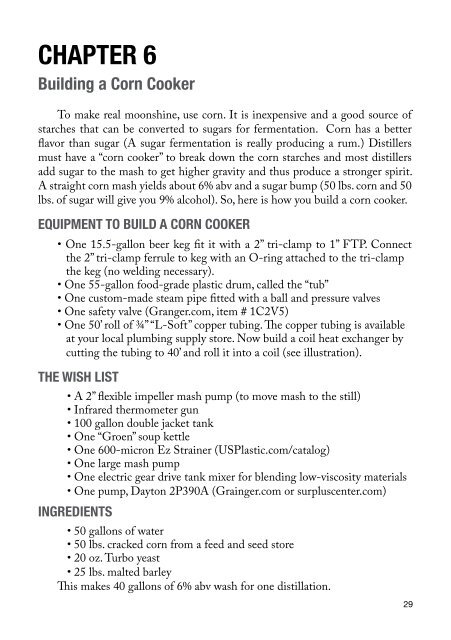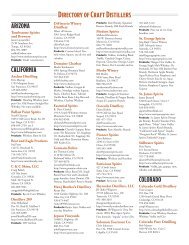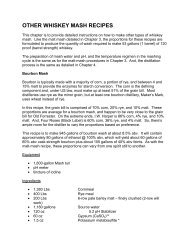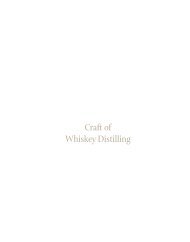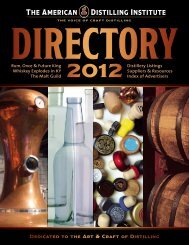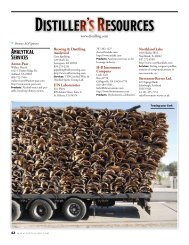CHAPTER 6 Building A Corn Cooker - The American Distilling Institute
CHAPTER 6 Building A Corn Cooker - The American Distilling Institute
CHAPTER 6 Building A Corn Cooker - The American Distilling Institute
Create successful ePaper yourself
Turn your PDF publications into a flip-book with our unique Google optimized e-Paper software.
<strong>CHAPTER</strong> 6<br />
<strong>Building</strong> a <strong>Corn</strong> <strong>Cooker</strong><br />
To make real moonshine, use corn. It is inexpensive and a good source of<br />
starches that can be converted to sugars for fermentation. <strong>Corn</strong> has a better<br />
flavor than sugar (A sugar fermentation is really producing a rum.) Distillers<br />
must have a “corn cooker” to break down the corn starches and most distillers<br />
add sugar to the mash to get higher gravity and thus produce a stronger spirit.<br />
A straight corn mash yields about 6% abv and a sugar bump (50 lbs. corn and 50<br />
lbs. of sugar will give you 9% alcohol). So, here is how you build a corn cooker.<br />
EQUIPMENT TO BUILD A CORN COOkER<br />
• One 15.5-gallon beer keg fit it with a 2” tri-clamp to 1” FTP. Connect<br />
the 2” tri-clamp ferrule to keg with an O-ring attached to the tri-clamp<br />
the keg (no welding necessary).<br />
• One 55-gallon food-grade plastic drum, called the “tub”<br />
• One custom-made steam pipe fitted with a ball and pressure valves<br />
• One safety valve (Granger.com, item # 1C2V5)<br />
• One 50’ roll of 3/4” “L-Soft” copper tubing. <strong>The</strong> copper tubing is available<br />
at your local plumbing supply store. Now build a coil heat exchanger by<br />
cutting the tubing to 40’ and roll it into a coil (see illustration).<br />
THE WISH LIST<br />
• A 2” flexible impeller mash pump (to move mash to the still)<br />
• Infrared thermometer gun<br />
• 100 gallon double jacket tank<br />
• One “Groen” soup kettle<br />
• One 600-micron Ez Strainer (USPlastic.com/catalog)<br />
• One large mash pump<br />
• One electric gear drive tank mixer for blending low-viscosity materials<br />
• One pump, Dayton 2P390A (Grainger.com or surpluscenter.com)<br />
INGREDIENTS<br />
• 50 gallons of water<br />
• 50 lbs. cracked corn from a feed and seed store<br />
• 20 oz. Turbo yeast<br />
• 25 lbs. malted barley<br />
This makes 40 gallons of 6% abv wash for one distillation.<br />
29
PROCEDURE<br />
Overnight: Soak 50 lbs. of cracked corn in a tub of hot water. <strong>The</strong> next day,<br />
drain the tub.<br />
Day Two: Repeat the process.<br />
Day Three: Repeat the process.<br />
[If you are planning to double distill, use three tubs, repeating the process<br />
above to create 120 gallons of wash.]<br />
COOkING THE CORN<br />
1. Set up the cooker (See illustration pg. 28) by inserting the steam pipe<br />
into the wash tub, making sure that it does not touch the bottom. Now add 40<br />
gallons of fresh water to the tub.Turn on the steam and start heating the water<br />
before adding the corn.<br />
Mix 15 lbs of the crushed malted barley into the corn. (This small amount of<br />
barley keeps the corn from becoming a thick porridge). Now, add the mixture to<br />
the mash tub. As the mash heats up and cooks the corn will gelatinize, making<br />
it difficult to stir. If necessary, add more water to mixture. An electric gear tank<br />
mixer (agitator) will make this job easier. It can take a few hours to bring it up<br />
to 212 º F.<br />
Note: <strong>The</strong> mash water needs to be at least 15 ppm calcium and almost devoid of iron.<br />
<strong>The</strong> pH should also be adjusted to about 6.0 (Most city water is 8-9 pH.) Not adjusting<br />
pH is the biggest reason mashes fail.<br />
2. Use caution and do NOT rush the cooking process as you are pushing live<br />
steam through a thick mash. This is not for beginners.<br />
3. Cook the mash for 1 hour, then turn off the steam system. Allow the copper<br />
pipe to cool. Use gloves to remove the steam pipe.<br />
4. Insert the copper “coil” heat exchanger into the mash. If you don’t have a<br />
coil, you will have to wait hours for the mash to cool. When the mash has cooled<br />
to 152 º F, remove the coil and use a wooden paddle stirring in 20 lbs. of malted<br />
barley to the wash. Again, the easy way to mix the mash is with an electric, gear<br />
drive tank mixer. Mixing in the barley malt will cool the mash another 10 º F, to<br />
around 145 º F.<br />
At 145 º F to 155 º F barley enzymes will convert corn mash to a sugar wash.<br />
Don’t worry about the starch conversion temperature. If it is between 130 º F<br />
and 160 º F conversion will happen because <strong>American</strong> 2-row barley has a lot of<br />
enzymes. (Keep the agitator running during starch conversion).<br />
30 Modern Moonshine Techniques
5. It takes over an hour for starch conversion to occur. Now for the second<br />
time, insert the cooling coil back into the wash, or just wait several hours for it<br />
to cool down. Many distillers wait over night for the mash to cool. This is not a<br />
good practice.Cool the mash from 143 º F to 70 º F. At 70 º F pitch the yeast.<br />
6. Use the infrared thermometer gun to double check the temperature of the<br />
wash. At 70 º F “pitch”, or mix in, 20 oz. of Turbo yeast. At this point oxygenate<br />
the mash by bubbling air through it. (Use a large aquarium pump)<br />
It you don’t oxygenate the mash, it will start to ferment and then stop around<br />
1.030 (gravity).<br />
31
7. <strong>The</strong> wash will take between 5 to 10 days to ferment. Remember, as the<br />
wash ferments it will heat up. <strong>The</strong> goal here is to “hold” the fermentation below<br />
75 º F. High temperature fermentations produce off flavors that come through<br />
during distillation.<br />
8. When fermentation is finished, there will be no more bubbles.<br />
9. If using a plastic drum as a fermentation tank use a sump pump to move<br />
the wash into the still. In order to get the last five gallons of liquid out it will be<br />
necessary to tip the tank. Drain the liquid through a Ez Strainer, leaving behind<br />
the corn pulp. This liquid, which is about 5 gallons, goes into the still.<br />
Note:Remember never pump corn solids into a direct fired still it should be strained to<br />
keep out solids.<br />
10. Keep two log books: one on cooking and fermentation of the wash, the<br />
other log for distillation. It is very important to keep records so that you do not<br />
make the same mistakes twice.<br />
11. Distill the wash. Make a fast run stripping alcohol from the wash to<br />
produce a low wine of 25% alcohol. Distill the low wine a second time (double<br />
distillation) in order to get moonshine that is 65% abv.<br />
12. Clean up the mess. (Do not drink while driving a car or distilling alcohol).<br />
Note: With everything said and done and you insist on distilling corn whiskey do it<br />
the easy way using pregelatinized precooked corn. Take a brewing class and learn how<br />
to make wash from precooked corn. <strong>The</strong> recipe is 80% corn, 20% barley.<br />
A whiskey distiller often runs into the late (tail) fraction with head<br />
temperature reaching 202 º F at the high end. When aging whiskey<br />
tails are sometimes added back as they “soften” in the oak barrel.<br />
Adding tails to a clear moonshine or unaged whiskey is avoided as<br />
they contain esters giving the drinker a headache.<br />
32 Modern Moonshine Techniques
DISTILLATION OF CORN WHISkEY (USING A POT STILL)<br />
Here is how.<br />
<strong>The</strong> yield from fermentation of a corn mash is 5% abv. <strong>Distilling</strong> this mash<br />
on a “primitive” pot still (without packing) will yield about 25% abv. [To get 80%<br />
abv on a single run requires having alcohol wash of 8 to 10% abv and a still with<br />
packing mesh or plates.] Many moonshine distillers “double” distill by taking 25%<br />
abv from the first run called low wines and distill it a second time yielding 50%<br />
abv. (100 proof ).<br />
DOUBLE DISTILLATION<br />
First run—5% abv low wine becomes 25% abv low wine<br />
• Distill the 40 gallons of wash by making a fast striping run<br />
(no heads or tails cuts) collecting 12 gallons of 25% abv.<br />
• Repeat this process three more times, each time collecting 12 gallons<br />
from each of 4 runs.<br />
Total 42 gallons.<br />
Second Run: 25% abv low wine becomes 60% abv.<br />
• Foreshots: Collect and toss the first 4 oz.<br />
• Heads & Hearts: Run together collecting 18 gallons of<br />
60% abv/120 proof.<br />
• Tails: Save tails and add them to the next distillation.<br />
SUMMARY<br />
Cooking corn mash, from start to finish, takes about 5 hours. Fermentation of<br />
the mash on average takes about a week. Making corn whiskey from scratch is a lot<br />
of work. Distillers do it because of tradition, but, more importantly, because corn<br />
is cheap.<br />
<strong>The</strong> problem with using corn to make whiskey is that it requires two distillations.<br />
<strong>The</strong> first distillation of a 5% abv wash will only yield about 25% alcohol<br />
(50 proof ). Double distilling the wash produces 50% alcohol or 100 proof. To<br />
run a more efficient still, moonshiners use sugar in the fermentation tub.<br />
<strong>The</strong> most efficient to make whiskey is on a column still (see chapter 11)<br />
where is it is easy to get a 100 proof whiskey on the first run. Most distillers<br />
learn the distillation process on a pot still before moving up to a column still.<br />
33
I suggest you make whiskey the modern way by first learning how to brew<br />
beer. Your local home brew shop hosts classes how to make “wash” from malt<br />
extract and how to use a mash tun to produce a beer wash. To be a whiskey distiller<br />
you need to learn how to make wash from malted barley, pre-gelatinized<br />
corn flakes, wheat and rye. Most important these beer washes will yield 8-10 %<br />
alcohol for distillation.<br />
Why did I devote two chapters of this book to building a corn cooker and<br />
distilling moonshine? Because, people prefer to do things the traditional way<br />
(often the hard way). It’s also the craftsmanship of producing a hand-crafted<br />
product. Or, perhaps they just like the “hot” taste of a good corn whiskey.<br />
Finally, if you have a still that is direct fire, I strongly recommend that you<br />
filter or strain all of the wash, keeping solids out of the kettle. If corn solids get<br />
into the kettle they will burn, producing an off-flavored spirit. If possible, build<br />
a still with steam jacket or, better yet, convert an steam jacketed brewing kettle<br />
into a still. Again, do not distill the fermented mash unless you have a steam<br />
jacketed still!<br />
It is important to separate the grain from the wash before distilling it.<br />
To operate a still you need a federal license known as a DSP permit. So get<br />
busy and get your state and federal licenses. And, then you will be welcomed to<br />
the industry as an artisan distiller.<br />
To obtain a detailed document titled “Steam Wand Mashing” go to: www.<br />
artisan-distiller.net. Special thanks to Sherman Owen of artisan-distiller.net for<br />
the information on how to build the corn cooker.<br />
34 Modern Moonshine Techniques
36 Modern Moonshine Techniques<br />
36


